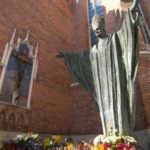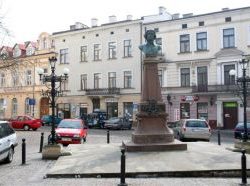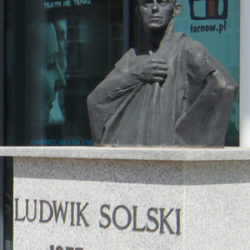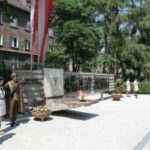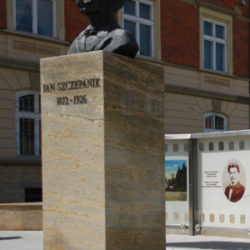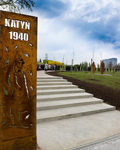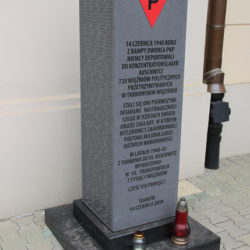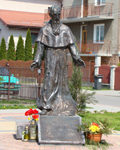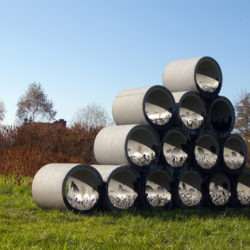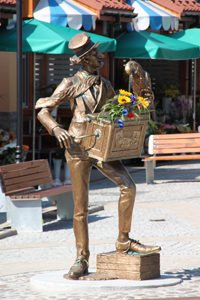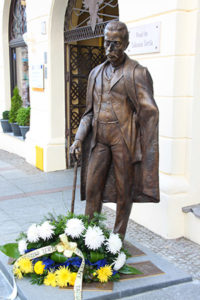| 1. Statue of John Paul II | |
|
|
Location: pl. Katedralny, S-E corner of the Cathedral Sculptor: Bronisław Chromy Date of unveiling: 29 June, 1981 Height: 5 meters |
| Relevance to Tarnów: Karol Wojtyła often visited Tarnów during his service as a Bishop and Metropolitan of Cracow. Pope John Paul II stayed in Tarnów on 9th and 10th of June, 1987. At that time, during his meeting with the citizens of Tarnów he said: “You do not realize how I have always enjoyed my visits to Tarnów”. It is one of the first statues of pope John Paul II in Poland! It is situated on pl. Katedralny, next to the southern wall of the Cathedral chancel. Bronze statue presents Pope in a canonical dress with wide open arms. | |
| 2. Victims of War and Fascism Monument | |
|
|
Location: ul. Narutowicza, in front of the Old Cemetery |
| The monument consists of two parts: three expressive kneeling figures constitute first part of the monument, second part is a concrete architectural structure with two “Grunwald” swords rising over it as well as a crying child by the wall (a symbol of life after the loss of the intimates). On the site facing Narutowicza street the two dates are engraved: 1939-1945, whereas the back wall was engraved with the following words: “In honor of 45 000 inhabitants of Tarnów region – the slaughtered victims of German fascism, the heroes who died for the independence of our homeland in the years 1939-1945”. | |
| 3. Sandor Petőfi Monument | |
|
|
Location: pl. Petőfiego by ul. Krakowska |
| Relevance to Tarnów: Sandor Petőfi (1823-1849), was Hungarian poet and adjutant of general Józef Bem during Hungarian revolution in the years 1848-1849. Bronze bust of the poet is placed on the granite pedestal against a background of a concrete three-dimensional composition. Monument is surrounded with green square with entrance through Székely Gate from Krakowska Street. Székely Gate was put in place in May 2001 by the Székelys. | |
| 4. Bust of Adam Mickiewicz | |
|
|
Location: center of pl. Kazimierza Wielkiego |
| The citizens of Tarnów commemorated the 100th anniversary of birth and the 45th anniversary of death of Adam Mickiewicz, one of the Three Bards (national poets of Polish Romantic Literature) by founding this statue. The bronze bust placed on a tall pedestal was installed between two ornamented candelabras. It is believed that the monument managed to survive German occupation as they assumed it was a bust of Goethe… | |
| 5. Statue of Mercury | |
|
|
Location: Sanguszków Park in Tarnów-Gumniska, in the backyard of Sanguszków palace |
| It is a replica of “flying” Mercury (Roman god of trade) statue from 1580 located in Florence. The statue presents a nude young boy wearing helmet with wings, similar wings growing from his feet and holding a staff (caduceus). The whole figure stands poised on the toes of the left foot. It is believed that statue was brought to Tarnów by one of the members of Sanguszko family – the then owners of the palace in Gumniska. | |
|
6. Statue of Wincenty Witos |
|
|
|
Location: pl. Drzewny by ul. Lwowska |
|
Relevance to Tarnów: Wincenty Witos (1874-1945) was the initiator and activist of Polish people’s movement, born in a nearby Wierzchosławice. Witos was a member of a parliament and thrice prime minister of the Republic of Poland in the interwar period. An imposing monument: the figure of Witos is presented upright, cast in bronze and placed on the granite pedestal. |
|
| 7. Tomb of the Unknown Soldier | |
|
|
Location: pl. Ofiar Katynia (Victims of Katyn Massacre Square) near ul. Wałowa Sculptor: Bronisław Kukla Date of unveiling: 28 June, 1931 |
| The first monument of unknown soldier was actually a plaque with an inscription: “To the Unknown Polish Soldier who sacrificed his life for the freedom of our homeland 1914-1920”. Anonymous author left the plaque by Adam Mickiewicz’s monument on plac Kazimierza Wielkiego on the night of 20 June, 1925. Erection of the monument in its present form was inspired by Tarnów branch of Towarzystwo Opieki nad Grobami Bohaterów in 1931. It is designed as a tumulus, made of porphyry and scattered rocks. It is crowned with a polyhedron modernistic pedestal with an iron light symbolizing an oil lamp (a few months after the unveiling urn with a soil from Cmentarz Legionistów in Łowczówek – the Polish Legions Cemetery – was placed inside). | |
| 8. Kazimierz Brodziński Monument | |
|
|
Location: ul. Piłsudskiego, in front of I Liceum Ogólnokształcące (high school) Sculptor: Walery Gadomski Date of unveiling: 17 July, 1884 |
| Relevance to Tarnów: Kazimierz Brodziński, Polish Romantic poet and publicist, was born on 8 March, 1791, in Królówka near Bochnia, and died on 10 October, 1835, in Dresden. He attended High School in Tarnów where he became familiarized with German language and literature. Bronisław Trzaskowski, headmaster of High School Number 1 in Tarnów, decided to commemorate Brodziński with a monument which would be situated nearby School’s main entrance. It is a bronze bust placed on a high stone pedestal. Original figure was destroyed by Germans in 1940 and than reconstructed in 1974. | |
| 9. Józef Szujski Monument | |
|
|
Location: ul. Piłsudskiego, in front of I Liceum Ogólnokształcące (high school) Sculptor: Piotr Kozakiewicz Designer of the pedestal: Jan Czuba, local stone-mason Date of unveiling: 1886 |
| Relevance to Tarnów: Józef Szujski was born on 16th of June 1835 in Tarnów and died on 7th of February 1883 in Cracow. He was one of the greatest Polish historians of his times, professor of the Jagiellonian University in Cracow and a co-founder of Przegląd Polski, monthly magazine dedicated to science and literature. He was also a member of a political group “Stańczyki”. The idea of erecting this statue was also Bronisław Trzaskowski’s, headmaster of High School Number 1 in Tarnów. It is a bronze bust placed on a tall stone pedestal. | |
| 10. Ludwik Solski Monument | |
|
|
Location: ul. Mickiewicza, in front of the Ludwik Solski Theater Sculptor: Xavery Dunikowski Date of realization: 1905 Date of unveiling in Tarnów: 11th June 1972 |
| Relevance to Tarnów: In September 1945, in a newly created Municipal Home of Culture (cultural center located in a building which earlier served as a seat of “Sokół” – Polish Gymnastic Society) the Old Theater was established, renamed to Ludwik Solski Municipal Theater on 28th of October of the same year. Solski – one of the greatest Polish actors, still performing at the time the Theater was created, not only agreed to use his name but also directed and performed on stage in Tarnów. The bronze bust figure presents Solski in one of his roles. It is a gift from the actor to his theater. | |
| 11. First Transport of Prisoners to KL Auschwitz Monument | |
|
|
Location: Plac Więźniów KL Auschwitz (Prisoners of KL Auschwitz Square) in front of former Jewish bathhouse (Mikvah) Sculptor: Otto Schier, Tarnów architect Date of unveiling: 14th June 1975 (on the 35th anniversary of the transport) |
| Relevance to Tarnów: The monument was erected in place from which a group of 728 people (Poles from Tarnów and its region) was taken by Nazis to the first transport to the concentration camp KL Auschwitz. The monument is made of stone and concrete (symbolizes Auschwitz striped garments) and iron elements. An iron frieze with figures (symbolizes march to Auschwitz) was realized by Marian Biedroński’s works, plastic elements on the concrete were forged by Alfred Gucwa’s stone works. | |
| 12. The Victims of Stalinizm Monument | |
|
|
Location: Plac Ofiar Stalinizmu (Victims of Stalinizm Square) by Lwowska street Originators: professor Stefan Daus, a sculptor and Wojciech Kosiński, doctor and architect Date of unveiling: 17th September 2000 |
| It is the first monument of that kind in Poland. Its corner stone was sacred by Pope John Paul II 16th June 1999 during a mass in Stary Sącz. The figure of woman symbolizes Poland from which three eagles fly away. The figure of woman was cast in bronze and the rocks are of red granite. Next to the monument an obelisk was placed with an inscription on the plaque: “In honor of the victims of stalinism in the years 1939-1956”. Tragic life of the victims is expressed in the form of an injured bird connected to the other birds by the V sign. This 6 meters high sculpture was cast in bronze and mounted atop granite pedestal (in the form of two cracked plates symbolizing tear of Poland after the outbreak of WWII. Stone elements are enriched with bronze bas-reliefs presenting the symbols of: the Kotwica or Polska Walcząca (Fighting Poland – a World War II emblem of the Polish Underground State and AK (Armia Krajowa – Home Army), Sybiracy Association, Katyń Massacre, Political Prisoners of Stalinism Association and dates of the phases of rebuilding new homeland. The stone plate was placed in front of the monument which allows people to put flowers. The idea of the monument was initiated by Social Committee for Building a Monument to Victims of Stalinism in Tarnów and is a tribute of the whole society of Małopolska region to the victims of stalinism and repressions in years 1939-1956. The monument is devoted to the following: Poles slaughtered in Katyń, Charków, Twer and other places of execution in the Soviet Union; Home Army soldiers slaughtered or repressed by NKVD; members of anti-communist Polish resistance movements sentenced to death or long-term imprisonment by Polish People’s Republic courts. |
|
| 13. General Józef Bem Monument | |
|
|
Location: ul. Wałowa, opposite to Plac Bohaterów Getta Originators of the monument: Bogdana Drwal, local sculptor and Stefan Niedorezo, graduate from Cracow Academy of Fine Arts Originators of the pedestal: project: Otto Schier sculptor: Eugeniusz Kłak, stone work craftsman Date of unveiling: 11 May 1985 Height: 2,5 m (the figure itself) |
| Relevance to Tarnów: General Józef Bem, National Hero of Poland and Hungary, was born in Tarnów on March 14, 1794 and died in Aleppo (Syria) on December 10, 1850. His ashes were ceremonially brought back to Poland in 1929 and laid in a grand Mausoleum in Strzelecki Park. As a result of his conversion to Islam (consequently, he changed his name for Murad Pasza), Bem could not be buried in the Tarnów Cathedral. The monument was initiated by Tarnów Friends of Hungary Association and erected in 1985. It presents a standing general wearing Hungarian uniform. His figure was cast in bronze in the Tarnów casting works of Roman Sapa and was mounted atop a granite pedestal. Other Bem’s monuments can be found in Ostrołęka, Poland and Budapest, Hungary. Bemowo – one of the districts of Warsaw was named after General. | |
| 14. General Józef Bem’s Mausoleum | |
|
|
Location: Strzelecki Park |
|
Relevance to Tarnów: General Józef Bem, the hero of Poland and Hungary, was born in Tarnów 14th March 1794 and died in Aleppo(Syria) 10th December 1850. The ashes of the general were ceremonially brought to Poland in 1929 and buried in a magnificent mausoleum in Park Strzelecki. As a result of the change of denomination(consequently he changed his name for Murad Pasza) could not be buried in the Tarnów Cathedral. In Park Strzelecki in the middle of a park pond there was erected a mausoleum-sarcophagus resting on six Corinthian columns. Its walls are inscribed with: |
|
| 15. St. Francis Monument | |
|
|
Location: ul. Bernardyńska 13, an outside courtyard of the Bernadine monastery Originator: Stefan Niedorezo-Cracow sculptor, co-author of Bem Monument next to Wałowa street Date of unveiling: 1985 |
| It is the figure of St. Francis cast in artificial stone and presenting the whole saint with a dog at his feet. | |
| 16. The Victims of the Galician Slaughter of 1846 Monument | |
|
|
Place: Old Cemetery in Zabłocie, Tarnów (in the vicinity of the monument of insurgents of the January Uprising of 1863) |
|
The monument is made from granite and marble cobblestones. The monument is engraved with inscription from the Bible: “He said, What have you done? Listen! Your brother’s blood cries out to me from the ground”. Engraved are names of 53 people who lost their lives at the time. |
|
|
17. The Fallen Fighters of the January Uprising of 1863 Monument |
|
|
|
Place: Old Cemetery in Zabłocie, Tarnów (in the vicinity of the Victims of the Galician Slaughter of 1846 Monument) |
| The monument is a mound made of sandstone crowned with a large cross. It carries a plaque with an inscription: “To those who died for the Homeland in 1863”. Another 300 marble tablets carry the names of the fallen insurgents. The monument is surrounded with the graves of the soldiers of Polish Legions and a tombstone of Rufin Piotrowski – an insurgent, a diarist and a teacher in Tarnów schools, who died in 1872 in Tarnów. | |
| 18. The Slaughtered Jews Monument | |
|
|
Place: Jewish Cemetery, ul. Szpitalna Originator: Dawid Beker – a sculptor Date of unveiling: 1946 |
|
This monument commemorates the Tarnów Jews who were slaughtered by Nazis on the area of the Jewish cemetery. It is in the form of a broken stone column(the only preserved element of the Tarnów New Synagogue, which was destroyed in years 1939-1941). On the column there is a plaque: “Here are buried 2 000 Jews who were savagely slaughtered by the German thugs from 11 June 1942 to 5 September 1943”. |
|
| 19. The monument – Mausoleum in memory of the “Szarych Szeregów” soldiers | |
|
|
Place: The Communal Cemetery in Tarnów-Mościce, ul. Czarna Droga Author of the project: mgr inż. Jacek Sumara Contractor: Azoty Chemical Works in Tarnów as well as “Chemobudowa” in Cracow Date of erection and unveiling: 30th September 1975 |
| The elements of the monument: a plate with four plaques, two high pillars embellished with some elements containing the quotes of B. Jastrun: “To co się stanie z kodeksem dziejów…Wyście pisali krwią i nadzieją”. After the victory of the “Solidarity”an iron cross(resembling that of Pope) was added. On the monument there are engraved 23 names of the fallen of whom the youngest was 12 years old and the eldest was 47. One of the inscriptions says: “They were killed struggling against Nazi occupiers in years 1939-1945. Honour to their remembrance” | |
| 20. The 5th Regiment of Mounted Riflemen | |
|
|
Place: al. Matki Boskiej Fatimskiej 2, next to ambulance service Originator: lieutenant Ujejski Date of unveiling: 9th September 1923 Date of unveiling of the commemorative plaque: 8th June 1929 |
|
The 3 metre high monument was initiated by commander of the regiment Aleksander Ehbar on the area of the Kłuszyńska Cavalry barracks in Tarnów. It is devoted to the fallen soldiers and officers of the regiment. It is made of concrete in the form of an obelisk crowned with an eagle with extended wings. The front plate is engraved with an inscription: “To soldiers and officers of the 5th regiment of mounted riflemen who died for our homeland-comrades in arms. 1920-1923”. Next to the monument in August 2002 four small obelisks were unveiled, first of them is devoted to Sybiracy, second one to WiN organization, third to political prisoners of stalinism and fourth to those who were conscripted into “Mining Battalions” instead of the army. |
|
| 21. Polish soldiers fallen on 6th and 7th September 1939 Monument | |
|
|
Place: ul. Krzyska, Municipal Cemetery in Tarnów-Krzyż Originator: Marian Skoczek Date of unveiling: 1951 |
|
It is made of concrete and Pińczów sandstone with a cast iron Piast eagle on the top. On the monument there is a plaque with an inscription: “Eternal glory to the heroes fallen for our homeland. 1945” and about 100 names of the fallen soldiers. |
|
| 22. Soviet soldiers monument | |
|
|
Place: ul. Krzyska, Municipal Cemetery in Tarnów-Krzyż Date of unveiling: 1948 |
| The monument is in the form of a marble cuboid crowned with a sandstone obelisk devoted to those who died during the liberation of Tarnów region in years 1944-1945. On the front stone plaque there is an inscription: “Honor and glory to those who died for the independence of Soviet Union and Poland”. | |
| 23. Bimah-remnants of the old Tarnów synagogue | |
|
|
Place: skwer Starej Synagogi/ul. Żydowska |
| It is the remnant of the oldest Tarnów synagogue. The Tarnów “Old” Synagogue was erected around 1630 or 1660. It was a Baroque brick building dominating over the neighboring residential buildings. During the occupation in November 1939 it was burnt and destroyed by Nazis three years later. The only preserved part is bimah. The “New” Synagogue (built in 1908) was also destroyed by Nazis. | |
| 24. St. Stanislas Monument | |
|
|
Place: ul. Pszenna, next to the St. Stanislas Kostka church (Tarnów-Zbylitowska Góra) |
| 25. “A warning to the drivers” Monument | |
|
|
Place: ul. Krakowska, crossroads with ul. Liściasta |
| On the monument there are four crosses and a steering wheel. Every cross symbolizes a child who was run over there by a drunken driver in June 1990. It cautions against irresponsible driving under the influence of alcohol. On the monument there is an inscription: “Do not drink, driver, you may kill someone!”. | |
| 26. Jan Szczepanik Monument | |
|
|
Place: pl. Szczepanika, by ul. Mickiewicza Originator: Michał Poręba Date of unveiling: 2002 |
| Relevance to Tarnów: Jan Szczepanik, “Polish Edison”, was born on 13th June 1872 in Rudniki near Mościska(Ukraine) and died 8th November 1926 in Tarnów. He was connected with Tarnów since 1902 when he married Wanda Dzikowska (born in 1879) in the Tarnów cathedral, she was a daughter of a famous Tarnów district doctor – Zygmunt Dzikowski. Szczepanik was connected with Vienna and Drezno by his occupation but he always returned to his family in Tarnów. After death he was buried in a grave of Dzikowscy family at the Old Cemetery in Tarnów. It is the first in the world monument of a gifted inventor-the pioneer of a colour photography, television and film,the precursor of a modern weaving industry and a bulletproof vest. | |
| 27. Holy Virgin Mary Figure | |
|
|
Place: pl. Katedralny Date of unveiling: 14th November 1884. |
| The founder of the figure was the then Bishop of Tarnów Józef Alojzy Pukalski. The monument was unveiled on the 30th anniversary of the announcement of the dogma concerning the immaculate conception and presents the Holy Virgin standing on the globe with a crescent moon at her foot. Furthermore, she is wearing a crown with twelve stars. The socle is engraved with: “Pray for us, Queen of Poland”. | |
| 28. “The Elephant” | |
|
|
Place: ul. Krakowska/ul. Nowy Świat The author of the project: Tarnów sculptor Jacek Kucaba Date of unveiling: 2001 |
|
The elephant was sculpted during summer holidays near Palace of the Youth in 2001. The same year the elephant was transported near CH Krakus at the crossroads of Krakowska, Nowy Świat and Mościckiego streets. Originally it was white however, it was painted by children in 2003. It is a common “meeting point”among the youth of Tarnów. |
|
| 29. Poets’ Bench | |
|
|
Place: ul. Wałowa, next to the “Mirror Ballroom” Originator: Tarnów sculptor Jacek Kucaba Date of unveiling: 3rd December 2004 |
| The figures of Agnieszka Osiecka, Zbigniew Herbert and Jan Brzechwa sitting on the main pedestrianized street of the city-Wałowa street on the bench in front of the building which houses the Mirror Room. The boxes placed next to them contain books with their works. | |
| 30.The tram stop | |
|
|
Place: ul. Wałowa, near the place of the former tram stop Date of unveiling: May 2004 |
| In years 1911-1942 Tarnów was the only provincial town of Galicia where trams run. Tarnów trams in red with blue and gold coat of arms were called “the ladybirds”. The length of the tram line was 2,5 kilometers. Every day from 6 a.m. to 10 p.m. with the frequency of 6 minutes run 6 trams. | |
| 31. Targ Słów “the Word Market” | |
|
|
Place: pl. Alicji i Jana Preissów, near the crossroads of Nowy Świat and Kopernika streets The author of project: Tarnów sculptor Jacek Kucaba |
| 32. Maszkaron “The Mascaron” | |
|
|
Place: Wielkie Schody street Originator: architect Witold Gizbert Studnicki, realizator of the sculpture: Henryk Hoch (Heschel) 1881-1943 Date of unveiling: 1936 |
| The author was inspired by the masks of the Tarnów Town Hall. The inhabitants of the then Tarnów originally thought it was the monument of the the founder of the city-Spycimir Leliwita. From the beginning it became the object frequently painted with graffiti; a photo from the thirties of the 20th century presents the mask painted with the inscriptions by the local communists. | |
| 33. The Monument to the 14th Kołobrzeg Mechanised Regiment | |
|
|
Place: ul. Szkotnik (the area of the former so called “lower barracks”) The author of the project: Jerzy Martynów Realization: Franciszek Machowski, Tarnów stone mason Date of unveiling: 20th May 2004 |
| Relevance to Tarnów: In years 1947-1993 in the so called “lower barracks” in Tarnów there were stationed the 14th Kołobrzeg Mechanised Regiment. The soldiers took part in the fights for Warszawa, Kołobrzeg as well as in the bloody fights for the breaking of Wał Pomorski where a heavy toll was taken as a result of a severely fortified area. During the ceremony of the unveiling of the monument an urn containing earth coming from battle fields(where 355 soldiers died) was placed. On the granite socle there is a large white Piast eagle and at the foot of the monument an inscription: “in this place there is buried an earth with blood of the fallen soldiers of the 14th Infantry Regiment from the battle fields of WWII” was engraved. |
|
| 34. The monument – boulder “In memory to the fallen for our homeland” | |
|
|
Place: ul. Panny Marii (the area of Our Lady of Scapular Sanctuary) Date of unveiling: 26th April 1992 |
|
This boulder commemorates patriotic celebrations which took place in this church during PRL period, for example on the anniversary of the outbreak of WWII and many more. On the monument there is an inscription: “To the fallen for our homeland” |
|
| 35. Rufin Piotrowski Tombstone | |
|
|
Place: Old Cemetery in Zabłocie, Tarnów (in the vicinity of the Victims of the 1846 Galician Slaughter monument) The author of the project: Antoni Kurzawa (sculptor) together with A. Pisz; realizator: Władysław Eliasz Date of unveiling: 1876 (four years after Piotrowski’s death) |
| Relevance to Tarnów: Rufin Piotrowski: an insurgent, a diarist and a teacher in schools of Tarnów, died in 1872 in Tarnów The monument is composed of stone blocks in the form of a steep pyramid on which a figure of a woman was placed (she symbolizes our homeland). In one hand she holds a medallion presenting the head of a man, in the other she keeps a laurel wreath. On the monument there is also placed a chain with broken shackles. | |
| 36. Brama Seklerska “Sekely Gate” | |
|
|
Place: pl. Petöfiego, by ul. Krakowska Date of unveiling: 26th May 2001 |
| Relevance to Tarnów: Székely Gate named after Józef Bem and Sandor Petöfi is a gift of a Hungarian foundation Irott Szó and Sepsiszentgyőrgy city for Tarnów city. It is the second, except for Stary Sącz, such gate in Poland. The day of the passing of the gate was connected with the 170th anniversary of the battle of Ostrołęka – one of the battles of the Polish November uprising in which Józef Bem participated. The word “Székely” (Siculi) means folk, nation and the mission of the defense of south-eastern borders of the Hungarian Kingdom. The Székely reside in the area located the farthest in the east in the Carpathian Mountains. They have played an important role in the Hungarian history and intellectual life. The medieval Székely self-government and military democracy was a one-of-a-kind phenomenon in feudal Europe. Till the 14th century the notion of Székely-siculitas-was tantamount to the notion of nobility. Modern history has been the sequence of various battles for rights. Székely gates constitute the embodiment of a peculiar folk awareness. They were made of different kinds of good quality oak trees and less frequently of pine trees. The structure of the gates resemble European craftsmanship technique whereas the layout of the ornaments (sculpted plants, mustaches and other symbols) symbolizes another world and have its source in the reality before the conquest of Hungarians who came from east. Among the gates built ages before on the large areas of eastern Europe the most numerous and technically interesting ones are preserved in Transylvania. Unfortunately they are completely forgotten in Europe. The traditional Székely hospitality does not allow gates to be closed. They are open to everybody, both happy and miserable, like open and philanthropic hearts of the Székely. It is expressed by the inscriptions on the arches of the gates: “Peace to the newcomers, blessing with the leavers”. |
|
| 37. The 16th Infantry Regiment of Tarnów Region Monument | |
|
|
Place: ul. Mościckiego, corner of ul. Szkotnik (the area of the so called “lower barracks)” Date of unveiling: 2002 |
| Relevance to Tarnów: In years 1918-1939 in the so called “lower barracks” in Tarnów there were stationed the 16th Infantry Regiment. During the September campaign it constituted the Cracow Army. In years 1939-1945 the soldiers of this regiment struggled for the independence of our homeland in partisan detachments of the Home Army. | |
| 38. The Slaughtered Young Poles Monument | |
|
|
Place: ul. PTTK (St. Martin Hill, east from the children’s playground) |
| On the small square covered with granite cobblestones there was placed a boulder with a cross(resembling that of scouts) and in the middle of the cross there is an inscription: “Here was murdered a group of young Poles slaughtered by Nazis 23rd December 1939…” | |
| 39. The Victims of WWII from Krzyż Monument | |
|
|
Place: ul. Krzyska, Parish Cemetery in Tarnów-Krzyż |
| It is a tapering sandstone obelisk with a cross on its top. It is devoted to the inhabitants of the then Krzyż village near Tarnów, who were killed during WWII. Two inscriptions engraved on the monument: “To God for glory, to people in order to remember the victims of WWII from our parish. The parishioners”. And below: “To the victims of concentration camps and WWII fronts”. | |
| 40. The Victims of WWII from Klikowa Monument | |
|
|
Place: ul. Zagumnie, Parish Cemetery in Tarnów-Klikowa |
| The monument is in the form of an altar with two granite polished stones. On first of them, a rectangular one there is an inscription: “And when years pass and the descendants forget about the fearful days of 1939-1945…”The second one is engraved with the map of Poland with the V-sign in the middle. | |
| 41. Wincenty Mucha Monument | |
|
|
Place: ul. Zbylitowska (Tarnów-Mościce, Wincenty Mucha Park) Date of unveiling: 1998 |
| Relevance to Tarnów: Wincenty Mucha was a leader of the scouting regiment and the founder of the Grey Ranks in Mościce. The monument was erected by the living scouts of the Grey Ranks. It commemorates scoutmaster W. Mucha and the scouts who struggled for an independent homeland. | |
| 42. Monument in the form of a stone, commemorating the establishment of the district „Za Torem” | |
|
|
Location: square at the intersection of ul. Obrońców Lwowa and ul. Czerwona in Tarnów – Mościce Date of unveiling:1998 |
| The monument commemorates the establishment of a new district on 2nd June 1934. The ceremony of laying the foundation stone was attended by Polish President Ignacy Mościcki and Tarnovian Bishop Franciszek Lisowski. The commission responsible for drawing up plans of the new district comprised of A. Miziewicz, S. Hupsch and E. Mrowiec.
This modest monument was founded by the inhabitants of Mościce to commemorate this event as well as the 80th anniversary of gaining independence and protecting Lvov. |
|
| 43. Statue of Roman Brandstaetter | |
|
|
Location: corner of ul. Wałowa and ul. Rybna Date of unveiling: 10th June 2008 Author: Jacek Kucaba, a sculptor from Tarnów |
| Relevance to Tarnów: Roman Brandstaetter, a brilliant expert on the Holy Bible, was born on 3rd January 1906 in Tarnów and died on 28th September 1987. He came from an intellectual Jewish family. In 1946 Brandstaetter changed his denomination and was baptized a Catholic in Rome.
The monument is a two-meter-high sculpture of the Tarnovian writer, poet, dramatist and translator. The figure of Brandstaetter, dressed in a beret, is leaning against the corner of a tenement house, smoking a pipe and looking at passers-by. |
|
| 44. “Kopijnik” situated between The Sekler Gate and the Monument of Sandor Petofi | |
|
|
Location: pl. Petofiego by ul. Krakowska Date of unveiling: 10th June 2006 in honour of Forgon Mihaly and 14th June 2008 in honour of Norbert Lippóczy |
|
“Kopijnik” is a gift donated to Tarnów by Hungarian cities. In 2008 another “kopijnik” was placed in Tarnów in honor of Norbert Lippóczy, a Hungarian who settled in Tarnów before the war to run a family winery and stayed in the city for the rest of his life. Lippóczy was regarded as an active social worker, history and art lover and sophisticated collector. Additionally, one of his greatest achievements was tightening relations between Poland and Hungary. |
|
| 45. The Way of the Cross in Tarnów – Krzyż | |
|
|
Location: ul. Krzyska 112, next to the church Date of unveiling the Way: 17th September 1989 (by archbishop Jerzy Ablewicz) Date of unveiling the figure of the Resurrected Christ: 16th December 1990 (by archbishop Jerzy Ablewicz) Author of the project/Design of 14 stations: Anna Pawłowska Author of the project/Design of the Resurrected Christ figure: Mieczysław Stobierski |
|
The Way of the Cross comprises 14 chapels, which are over three meters high and crowned with metal cases. The cases contain canvases presenting the Passion of Christ, which were painted in the second half of the 19th century by Italian painter Luigi Morgari. Later Anna Pawłowska and Zofia Pawłowska from the Restoration Workshop at the Diocesan Museum in Tarnów worked on the conservation of the paintings. On the square where the Way of the Cross is located you can also see an imposing cross made of oak. At the end of the Way you will encounter a statue of Christ placed on a 1,9 meter high socle. The stone sculpture, which was made in the years 1989-1990, depicts Christ in the moment of Resurrection. |
|
| 46. The Cross | |
|
|
Location: ul. Mościckiego 177 Date of unveiling: 1888 Founders: Marcin Kozioł, Marianna Kapust, Marcin Solok |
| It is a stone figure with the image of Christ, adorned with bas-relieves. | |
| 47. The Cross | |
|
|
Location: ul. Mościckiego 143 Date of unveiling: 1925 Founders: Ignacy and Maria Zając |
| It is a stone cross in Neogothic style with the image of Jesus Christ, placed on a high pedestal | |
| 48. The statue of the Blessed Virgin Mary of the Immaculate Conception | |
|
|
Location: ul. Mościckiego 203 Date of unveiling: 1928 Founder: Michał Rogóż |
| It is a stone statue placed on a concrete pedestal and protected with a decorated roof | |
| 49. The statue of the Blessed Virgin Mary of the Immaculate Conception | |
|
|
Location: ul. Chopina 15, at the corner of ul. Matejki Date of unveiling: 1890 Founders: Michał and Apolonia Mondel |
| It is a stone statue placed on a concrete pedestal | |
| 50. Monument to Andrzej Małkowski | |
|
|
Location: pl. Andrzeja Małkowskiego, at the intersection of ul. Krakowska, ul. Bema and ul. Bandrowskiego Author: Michał Poręba Date of unveiling: 19th September 2008 |
| Relevance to Tarnów: Andrzej Małkowski was educated in Tarnów. Andrzej Małkowski is one of the creators of Polish scouting, its excellent trainer and theorist. He was also an activist in Polish youth and independence movements. The monument (bust) is made from sandstone. | |
| 51. The Monument of John Paul II – “The Effulgent Pope” | |
| Location: pl. Ojca Św. Jana Pawła II, next to Bl. Karolina Kózka Church Author: Tarnow sculptor Jacek Kucaba Date of Unveiling: 16th October 2008 Height: the socle is integral with the sculpture: 10 m; the sculpture alone is 3.3-m-high |
|
| Relevance to Tarnów: Karol Wojtyła often visited Tarnów during his service as a Bishop and Metropolitan of Cracow. Pope John Paul II stayed in Tarnów 9th and 10th June 1987. At that time, during his meeting with the inhabitants of Tarnów he said: “You don’t even realize how much I like to visit Tarnów”. The monument is placed on the same spot where on 10th June 1987 the Pope beatified Karolina Kózkówna. 2 million people were present there, mostly farmers from all of Poland. Before the Pope started the liturgy, he had said: “I am happy to be here with you, this land has always been close to me”
The sculpture of the Holy Father pervades compositionally the socle, which is made of reinforced concrete covered with granite. There are flowers, in Papal and national colours, placed in the hollows of the socle. |
|
| 52. “The Grave of People exiled to Siberia” | |
| Location: Old Cemetery (burial plot XIV), ul. Narutowicza Height: about 2 metres The project and realization: Olgierd Wójcik and Olgierd Sakowicz (with help of Otto Schier) Date of unveiling: 29th September 1996 |
|
| The monument is composed a two-metre-high white, stone cross placed on a rather low socle. There is an eagle (a Polish ensign) as well as a symbol of people exiled to Siberia (braided letters S and Z) placed on the cross. There is an inscription on the socle: “To pay homage to Siberia and Katyń, and for knowledge and remembrance of the living 1939 – 1956”. | |
| 53. Post-glacial granite boulder “The Pilgrim” | |
|
|
Location: al. Tarnowskich |
| Placed in 1983 at the intersection of 21′ E meridian and 50′ N parallel. The initiator of placing the boulder was dr Franciszek Pulit. | |
| 54. Post-glacial boulders “The Triplets” | |
| Location: ul. Piłsudskiego, vis-a-vis the swimming pool, on parking lot Dimensions: height: 2 m, perimeter: 10,2 m, Weight: around 28 t |
|
| Three erratic boulders (one bigger than others) called “The Triplets” were found in 2001 in Rzędzin District on Tadeusz Więckowski’s field (behind Bl. Karolina Kózkówna Church) and moved to the current location. | |
| 55. Plaque (obelisk) commemorating construction of Zakłady Azotowe w Tarnowie – Mościcach | |
|
|
Location: ul. Kwiatkowskiego, in front of head office of the factory Date of unveiling: 12th October 1990 |
| A replica of the plaque placed on the wall of the building of Oddzial Kwasu Azotowego, commemorating the opening of Państwowe Zakłady Azotowe w Mościcach (the biggest factory in Tarnów) on 18th January 1930. | |
| 56. The assemblage of four small boulders arranged on the 5th Regiment of Mounted Riflemen square in memory of “Miners – Soldiers”, WiN organization, Political Prisoners and people exiled to Siberia | |
|
|
Location: pl. 5. Pułku Strzelców Konnych (al. M.B. Fatimskiej) Dates of unveiling: “Miners – Soldiers”: 1995 WiN organization: 25th August 2002 Political Prisoners: 25th August 2002 People exiled to Siberia: 2002 |
| 57. The obelisk commemorating the death of fire-fighters in 2004 in Tarnów | |
|
|
Location: ul. Klikowska 39, in front of the Fire Brigade Headquarters Date of unveiling: 14 May, 2005 |
|
The obelisk commemorating the death of Roman Rogoziński and Grzegorz Wolak, firefighters who died during the night of the 12/13 June 2004 while putting out the fire of the restaurant “Podzamcze”, located on St. Martin Hill. The year 2004 was the most tragic in the history of Tarnów Fire Service. |
|
| 58. The Monument of Mother of God Queen of Poland surrounded by King John II Casimir, M. Kolbe and S. Kostka | |
|
|
Location: ul. Zbylitowska 5, in front of parish church in Tarnów – Mościce Date of unveiling: 1984 |
|
The group of figures consists of 4 statues: in the middle the biggest one, the statue of Mother of God, on the right side is the statue of king of Poland John II Casimir, who is offering a crown to her, which is illustrating his vows from 1965. On the left are much smaller statues of Maximilian Kolbe and Stanislaw Kostka. The monumental concrete figures constituted the main altar of the Holy Virgin Mary Queen of Poland Church, completed in 1963. As a result of complete reconstruction of the main altar, carried out on a large scale in 1984, the statues were moved to the current location. |
|
| 59. The Monument of King Władysław Łokietek | |
|
|
Location: Square at ul. Wałowa 7, against the City Walls Author: Czesław Dźwigaj (professor of the Academy of Fine Arts in Kraków) Date of unveiling: July 2, 2009 Height: 3,5 m figure, 1,5 m socle |
| Relevance to Tarnów: On 7 March 1330, king Łokietek issued to Spycimir Leliwita document granting Tarnów city rights. It allowed location of the town on Magdeburg Law, introducing the right to self-governance and criminal court. The document was issued in recognition of numerous services and contributions (servicia plurima et merita) Spycimir had made to the King Władysław Łokietek and his courage in a battle against Hungarians. Spycimir has located town on a top of a hill (226 m above sea level). The oldest copy of the document is kept at Czartoryskich Museum in Kraków and the second one in Regional Museum in Tarnów. On 15 May 2008 members of the Tarnów City Council passed a resolution No XXI/311/2008 allowing the erection of the statue of king Władysław Łokietek on ul. Wałowa 7.
Chamber of Commerce in Tarnów, TK Development – developer of “Tarnovia” Shopping Mall and the Local Government of Tarnów has contributed to creation of the monument and its surroundings. It is believed that touching King’s shoe with right hand brings luck and makes dreams come true. |
|
| 60. Oaks of Katyń Ave | |
|
|
Location: ul. Wojska Polskiego, facing Legionów H. Dąbrowskiego residential area Date of unveiling: 20th of April 2009 |
| Relevance to Tarnów: In April 2009, twenty six oaks commemorating the 69th anniversary of the Katyń Massacre were planted. Each oak represents one citizen of Tarnów (or localities) murdered by the Russian secret police. They were killed with a shot in the back of the head in Katyń in 1940.
In April 2010, nine more oaks were planted – eight to commemorate the victims of 1940 massacre, and one to honor the victims of the presidential plane crash in Smoleńsk. The passengers were on their way to official celebrations of the 70th anniversary of the Katyń Massacre. Among the victims were: Lech Kaczyński, President of the Republic of Poland, and his wife; Sławomir Skrzypek, president of the National Bank of Poland and Wiesław Woda, MP from Tarnów. None of the 96 passengers aboard survived the crash. Each of the oaks is accompanied by information plaque. Several metal figures of soldiers, arranged in a little birch copse, complete the monument. Oaks of Katyń Ave in Tarnów is a part of a nation-wide program – ‘Katyń… save from oblivion’ (“Katyń… ocalić od zapomnienia”). |
|
| 61. Black Oaks in Tarnów | |
| Location: parking lot of “Zajazd pod Dębem” Inn, ul. H. Marusarz 9B Date of unveiling: about 1985 |
|
|
Relevance to Tarnów: In the 1980s, ten thousand-year-old black oaks were dug out from the gravel-pit on the river Wisłoka in Latoszyn, near Dębica. After being transported to Tarnów, the oaks were placed in front of an inn, which was just about to be opened, giving the newly established accommodation facility its name – “Pod Dębami”, or ‘the Oaks Inn’. At first, the oaks were planned to be placed at St Martin’s Hill, marking a symbolic border of the Carpathian Mountains (St. Martin’s Hill is the northernmost hill of the Carpathians). |
|
| 62. Obelisk Commemorating the First Transport of Prisoners to KL Auschwitz | |
|
|
Location: Platform no.1, main train station in Tarnów Date of unveiling: 14th of June 2010 (70th anniversary of the Transport) |
|
Relevance to Tarnów: On 14th of June 1940, from the train station in Tarnów, a transport of 728 prisoners left for Auschwitz. They were mostly political prisoners held imprisoned in Tarnów. They became the first victims of the most fatal concentration camp in the history of the World, where the Nazis murdered over one and a half million people of many nations. Over 50 transports of prisoners, totaling to 7,000 people, were sent from Tarnów to Auschwitz between the years 1940 and 1943. 728 names are inscribed on the monument. |
|
| 63. Monument to St Maximilian Kolbe | |
|
|
Location: square at the intersection of ul. Bajana and ul. Dąbka Author: Ewa Fleszar Date of unveiling: 14th of August 2010 (69th anniversary of Kolbe’s death) Height: some 2 meters |
|
The monument is made of bronze and stands on a granite plinth. The Saint wears a habit and stretches his hands in a gesture of love. A striped garment, wore by all prisoners of the KL Auschwitz, is presented on front of the plinth. The monument has been placed in a so-called ‘district of heroes’, section of Tarnów (the streets are named after Polish heroes, for example major H. Sucharski, colonel S. Dąbek, general H. Kleeberg). The monument was unveiled at the beginning of ‘the Year of Kolbe’ in the Catholic Church, which preceded the 70th anniversary of the martyrdom of St Maximilian Maria Kolbe in concentration camp in Auschwitz. |
|
|
64. The Sculpture by Wilhelm Sasnal in Tarnów – Mościce |
|
|
|
Location: ul. Chemiczna, next to Tarnów-Mościce train station Author: Wilhelm Sasnal Date of unveiling: 29th of August 2010 Height: around 4 meters |
|
Mościce is a industrial section of Tarnów, where Wilhelm Sasnal grew up. The Sculpture is in a form of pyramid made of cement rings and covered with adhesive. Inside one of the rings a date: 28.03.1983 is inscribed. The author explains that random date as a symbol of an incident that might have, but has never occurred. It recalls the years of Russian occupation of Poland, after the WWII, and state of permanent stress and threat among citizens of Mościce, assuming that the nearby Nitrogen Works is target for the missiles from beyond the Iron Curtain. |
|
| 65. Statue of Our Lady in Tarnów-Mościce | |
| Location: corner of ul. ks. Indyka and ul. Traugutta Date of unveiling: 26 October, 2002 Height: 5 m |
|
| The Statue is located on site of St Therese of the Child Jesus chapel which stood there between 1931 and 1956. The statue was funded by Zakłady Azotowe w Tarnowie-Mościcach S.A. (Grupa Azoty ) in 2002. | |
| 66. Crucifix and Statue of Our Lady in Tarnów-Mościce, os. Dąbrówka | |
| Location: corner of ul. Zbylitowska and ul. Czarna Droga Date of unveiling: May 2002 Height: 3,5 m |
|
| The present Crucifix replaced an earlier one as the heritage protection department dates the cast iron figure of Jesus Christ to 1860. In 2002 figure of Our Lady of Piekary Śląskie was added. | |
| 67. Crucifix and Statue of Our Lady in Tarnów-Mościce (Świerczków) | |
| Location: corner of ul. Witosa and ul. Azotowa Date of unveiling: after WWI |
|
| The Carpathian Front of WWI cut off the people of Świerczków from a cemetery located in neighboring Zbylitowska Góra, forcing them to bury the deceased in other location. Total of 5 adults and 2 children rested there. The Crucifix was placed on site of that temporary graveyard. Shrine of Our Lady and few benches were added in the 1970’s. May Devotions to the Blessed Virgin Mary are held there. | |
| 68. Statue of Eugeniusz Kwiatkowski | |
|
|
Location: ul. Kwiatkowskiego, outside Grupa Azoty head office Author: Stanisław Szwechowicz |
|
Structure of the monument refers to an earlier work of Stanisław Czechowicz also dedicated to Kwiatkowski, which author created in Gdynia. It has however been adjusted to suite the location. A 2.48 m long sash symbolizes great Vision and Action, two distinctive qualities of Kwiatkowski, pragmatic scientist and engineer yet romantic seer. Relevance to Tarnów: From 1931 to 1935 Kwiatkowski was the CEO of two chemical plants – in Chorzów and the one in Tarnów-Mościce. Then, he moved to Warsaw and became the vice-Prime Minister and the Secretary of the Treasury until 30 September, 1939. He wrote his monumental economic thesis “Dysproporcje. Rzecz o Polsce przeszłej i obecnej”. |
|
| 69. Busts of Eugeniusz Kwiatkowski and Ignacy Mościcki | |
|
|
Location: ul. Jarzębinowa (Eugeniusz Kwiatkowski Park), in backyard of Dyrektorówka or Dom Chemika (home of the company CEOs) Date of unveiling: 2012 |
|
Relevance to Tarnów: From 1931 to 1935 Kwiatkowski was the CEO of two chemical plants – in Chorzów and the one in Tarnów-Mościce. Then, he moved to Warsaw and became the vice-Prime Minister and the Secretary of the Treasury until 30 September, 1939. He wrote his monumental economic thesis “Dysproporcje. Rzecz o Polsce przeszłej i obecnej”. Ignacy Mościcki, President of Poland, was the father of Państwowa Fabryka Związków Azotowych (chemical company, its present name is Grupa Azoty). The whole site where new investment was located was named after the President. The “Mościce” won national contest for a name of new locality. |
|
| 70. Bust of John Paul II | |
| Location: ul. Krzyska 114, in front of Gimnazjum nr 6 school building Sculptor: Bartłomiej Bałut, local artist Date of unveiling: 17 September, 2006 (consecrated by Wiktor Skworc, Bishop of Tarnów) |
|
|
Karol Wojtyla often visited Tarnów during his service as a Bishop and Metropolitan of Cracow. Pope John Paul II stayed in Tarnów 9th and 10th June 1987. At that time, during his meeting with the inhabitants of Tarnów he said: “You don’t even realise how much I like to visit Tarnów”. The bust is located in Krzyż district, in front of the Saint John Paul II Gimnazjum. It is cast in bronze and rests atop granite pedestal inscribed with the Pope’s sentence in Polish, meaning: “You must be strong with the strength of faith. You must be strong with the strength of hope. You must be strong with the love that rejoices in the right.” |
|
| 71. Monument of John Paul II | |
| Location: ul. Piłsudskiego 9, gardens of the Oratory of Saint Philip Neri Sculptor: Zdzisław Majchrowicz Height: natural size |
|
| Karol Wojtyła often visited Tarnów during his service as a Bishop and Metropolitan of Cracow. Pope John Paul II stayed in Tarnów 9th and 10th June 1987. At that time, during his meeting with the inhabitants of Tarnów he said: “You don’t even realize how much I like to visit Tarnów”. | |
| 72. Katyń Boulder Memorial Monument | |
| Location: ul. Bitwy pod Studziankami, in front of Gimnazjum nr 4 school building Date of unveiling: 20 April, 2009 – on the 69th anniversary of the Katyń Masacre |
|
| 73. Group of Four “Spatial Sculptures” inspired by the visions of Dagarama | |
| Location: E. Kwiatkowskiego Park in Tarnów-Mościce Author: Marcin Zarzeka Date of unveiling: August, 2011 Height: 1.5 – 2 m |
|
| Relevance to Tarnów: Jan Głuszak Dagarama (1937-2000), visionary born in Tarnów, had to quit architecture at the Kraków University of Technology because of schizophrenia. He did, however, managed to learn works of various architects-visionaries which inspired his own creations. None of his visions has ever been physically realized, nevertheless won wide recognition and appreciation. He ended up working at District Museum in Tarnów as a night guard. The Museum has commemorated Dagarama with a plaque (maintains constant temperature of 37.5 C all-year-round) mounted against a facade of a house Rynek 21.
The four sculptures were unveiled as part of “Tarnów. 1000 years of modernity” project by BWA Tarnów Art Gallery. |
|
| 74. Cenotaph of Sybiracy (Poles exiled to Siberia) | |
| Location: Cmentarz Stary (Old Cemetery), next to the Sanguszko Chapel Authors: Olgierd Wójcik, Olgierd Sakowicz, Otto Schier Date of unveiling: 29 September, 1996 Height: 2 m |
|
| Tall cross made of white stone adorn with national emblem of Poland and logo of Związek Sybiraków (Sybiracy Association) atop a pedestal with an inscribed plaque in Polish, meaning: “To honor all victims of Siberia and Katyń and for the living ones to learn and remember 1939-1956”. | |
| 75. Kataryniarz – Organ Grinder | |
|
|
Location: pl. gen. Józefa Bema, N-E corner of popular “Burek” marketplace Authors: Arkadiusz Latos (idea and inspiration: Jacek Adamczyk) Date of unveiling: 5 July, 2014 Height: 2.3 m |
| Relevance to Tarnów: According to historic records and old postcards, organ grinders were instantly present on the streets of prewar Tarnów. One of their favorite places was exactly the site where the monument is located. Bronze cast figure of an organ grinder is shaped in their most recognizable pose, with hand organs and a parrot sitting on his shoulder. The instrument is adorned with reliefs representing 3 most widely recognizable of Tarnów monuments: Town Hall, Cathedral and the Bimah. The statue plays several standards of the organ grinders’ repertoire upon approach allowing more intense experience of the past. | |
| 76. Bust of Hetman Jan Tarnowski | |
|
|
Location: ul. Mickiewicza 16, in front of III Liceum Ogólnokształcące (high school) |
| Relevance to Tarnów: born in Tarnów, considered one of the greatest military commanders in Polish history, Grand Crown Hetman since 1527, castellan of Kraków and Wojnicz, voivode of the Ruthenian and Kraków Voivodeships. | |
| 77. Statue of Tadeusz Tertil | |
|
|
Location: western side of Rynek – the Town Square, by the entrance to Pasaż Tertila |
| Relevance to Tarnów: born in Tarnów, Mayor of the city from 1907 to 1923. The statue is a life-sized figure of Tertil (commonly called “the Mayor of Independence”) standing in front of his house and presenting four of the city’s greatest investments that he made while in the office: power station, water supply system, train station and tram line. | |
| 78. Borderland Mound | |
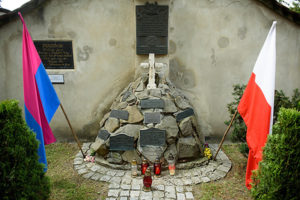 |
Place: To the left from the Main Gate Date of unveiling: 2nd June 2001 |
|
On the cemetery wall there is a commemorative plaque. Underneath it, the mound made of stones surmounted with a white cross which is rooted into the mound, was made. On the stones inscriptional boards were placed Inscription on the plaque: In tribute to our compatriots from Lviv and from south-eastern borderlands of the 2nd Republic of Poland, who died for their homeland and to those who were murdered in years 1939-1947 / Towarzystwo Miłośników Lwowa i Kresów Południowo-Wschodnich. (This society cultivates the memory of Lviv and the south-eastern borderlands.) Inscriptions on the boards: In tribute and in order of eternal memory to Heroical Lviv Eaglets / community of primary school nr 9 im. Orląt Lwowskich w Tarnowie. Volyn and eastern Lesservoivodeship / Ukrainian nationalists from the organisation OUN-UPA killed over 250 000 Poles. Lviv, for prisons „Brygidki” and „Łąckiego” / Places of mass murder of prisoners done by NKWD in 1941. Murdered by Ukrainian nationalists/ residents of counties Hrubieszów and Tomaszów Lubelski in March 1944 / We praise you and remember you! Eternal peace to fellow countrymen from Kut, murdered by Ukrainian bands in the Second World War. 4th July 1941 / Lviv-Wuleckie Hills, place of the massacre of Lviv professors murdered by Nazi German occupation forces and Ukrainian nationalists. To murdered by UPA in years 1939-1947 / residents of Brzeżan and of county Brzeżański/ from Borderland citizens. |
|
| 79. Jozef Pilsudski Monument | |
 |
Place: al. Solidarności, in front of the tarnovian outpost of Provincial and Marshal’s office. Authors of the project: Sculptor from Danzig prog.Stanisław Szwechowicz and tarnovian architect Artur Grodziński (author of the development of the terrain) Date of unveiling: 11th november 2019. Height: The bronze sculpture – 2,20 m(weight: 400 kg) placed on the granit platform ca 3m |
|
The monument depicts figure of the Marshal, standing with his hand on a sabre In the future, around the monument, educational path will be created. Containing the most important dates from the life of the Marshal Pilsudski. Additionally, benches with audio system from which there wil a possibility of listening to the history of his life, will be also placed there. Connections between Pilsudski and Tarnow: Did you know that Jozef Pilsudki used to visit Tarnow, e.g. He inspected the drills of local branch of „Strzelec” riflemen’s association – first time in 1913, and then immediately before the First World War, in July 1914? Did you know that on 29th November, 1927 prince Roman Sanguszko presented Marshal Pilsudski a thoroughbred stallion from his own stables located in Tarnow. Could the stallion replace Piłsudski’s beloved mare? |
|
| 80. Kneeling Girl with Braided Hair |
|
| Place: ul. Parkowa 25 Author of the project: Władysław Burkat Date of unveiling: The sculpture was found while demolishing a house at the corner of al. 1 Maja and ul. Klikowska, in 1975 Height: The sculpture ca. 2 m |
|
| The sculpture was found inside a house at present al. 1 Maja street, which was being demolished at the time. Initially, the sculpture was exhibited at ks. J. Popiełuszko square, in front of Tarnovia hotel before it was moved to its current location at ul. Parkowa 25. | |
|
81. The stone monument commemorating the visit of John Paul II on the Tarnów land. |
|
 |
Location: ul. Traugutta in the direct neigbourhood of Jaskółka Tarnów Arena Date of unveiling: 18 May, 2020 (100th anniversary of st John Paul II’s birth) |
|
The table on the stone bears the following inscription: “From this place, on June 9, 1987, Saint John Paul II began his apostolic visit to Tarnów. On the hundredth anniversary of the birth of John Paul II. Inhabitants of Mościce. Tarnów – Mościce 2020“ Karol Wojtyła, when he was the Bishop and the Metropolitan of Krakow, he was frequent visitor to Tarnów. As the Pope, John Paul II arrived in Tarnów from Lublin and landed in Mościce on June 9, 1987 about 8:45 P.M. The day after (Wednesday) at 4:45 P.M., he departed for Kraków from the same site. The moment before the Pope’s arrival at 8:00 P.M. church bells from all 666 parishes of Tarnów Diocese began to ring, including 17 in Tarnów. Among the ones who greeted John Paul II were: Bishop Jerzy Ablewicz together with Bishops (Piotr Bednarczyk, Józef Gucwa and Władysław Bobowski), priests (Prelate Dean K.Kos, Prelate Dean J.Rec – the Rector of Mościce, Prelate E.Łomnicki, Prelate W.Kostrzewa, Professor M.Bednarz, S.Sojka, Professor A.Kokoszka) and two little kids with flowers for the Holy Father. Provincial and city authorities were represented by: Chairman of the Provincial National Council Mieczysław Menżyński, Tarnów Voivode Stanisław Nowak, Vice-voivode of Tarnów Marian Chudzik, the President of Tarnów Mieczysław Strzelecki and the Director of Denominations Department UW – Franciszek Styczeń. |
|
Original text by Marcin Pałach, Tarnów Tourist Information Centre
Photos: Tarnów Tourist Information Centre, City of Tarnów
Created: 01-06-2007; last update: 23-08-2021
Bibliography:
“Tarnów-Wielki Przewodnik” joint work, published by Tarnowskie Towarzystwo Kulturalne and Muzeum Okręgowe in Tarnów
“Mój Tarnów” Antoni Sypek, foundation “Tarnowskie Towarzystwo Przemysłowe” and Izba Przemysłowo-Handlowa in Tarnów, Tarnów 2005
“Pomniki i Miejsca Pamięci Narodowej” joint work, published by PTTK Oddział “Ziemi Tarnowskiej”, Tarnów, 1st edition
Translated by: Paweł Rybak, Magdalena Łazarz, Iwona Kras, Wojciech Malig, Katarzyna Balcerek
